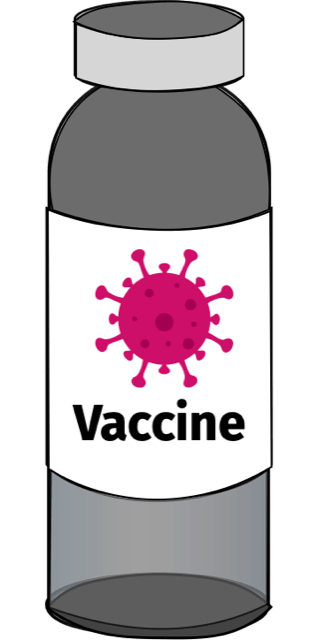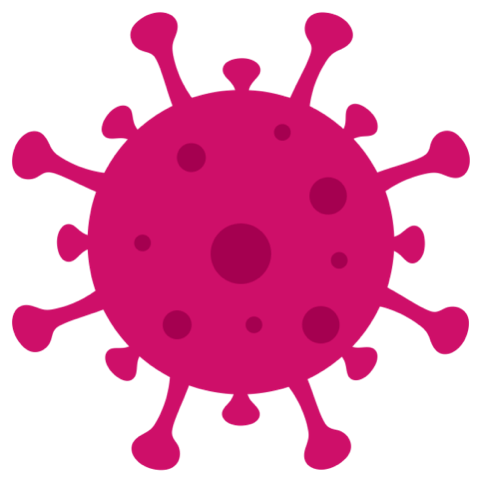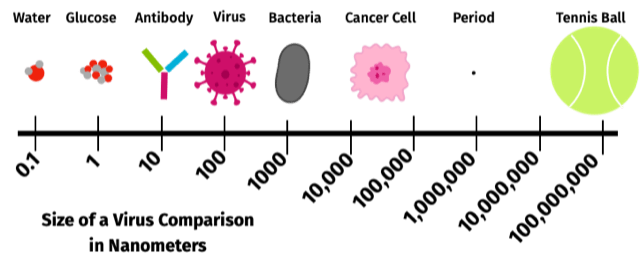Watch the video for a simple demonstration of how antibodies fight viruses and then do it at home!
What You Need:
-
Writing Utensil
-
Construction Paper
-
Hole Puncher
-
Scissors
The Science Behind Vaccines:
We are currently living through a global pandemic. Severe acute respiratory syndrome coronavirus 2 (SARS-CoV-2) is a virus, or more specifically a coronavirus, that is engulfing the world. It is also referred to as the “Novel Coronavirus.” It can produce a potentially deadly respiratory disease called Coronavirus Disease 2019 (COVID-19).
A virus is a microscopic germ made up of genetic material (DNA or RNA). It is covered by a capsid (shell) of protein. It might also have a fat-like lipid membrane. Viruses are small, some tens to hundreds of nanometers in diameter, which is a fraction of the size of human blood cells.
A virus cannot reproduce by itself. When outside a target cell, the complete virus is known as a virion. It first must identify a target host cell. It then either enters the cell or releases its genetic material into the host cell. When it does, it takes over the cell and uses the cell’s genetic material to reproduce. making many copies of itself.
The body fights viruses by producing lymphocytes, a type of white blood cell. The body’s innate immune system is always active and is the first to attack the virus. After three to four days, the body’s adaptive immune system becomes active and produces T-cells and B-cells, which recognize foreign material known as antigens, and target specific viruses. Y structure proteins called antibodies are produced by B-cells when confronted by antigens.
The body also produces pyrogens that result in a higher body temperature (a fever). The fever, although uncomfortable, helps to fight the virus by slowing down its replication.
Tests that detect if someone has been infected look for two different things.
- Some tests search for the virus itself and determine if a person is currently infected.
- Other tests look for antibodies that have been produced in response to an infection and tell if a person had been infected in the past and could have immunity from further infection.
To protect people from viruses, vaccines have been developed. Not only do vaccines protect individuals from a virus, they also create something called “herd immunity” where a large percentage of the population becomes immune.
Vaccines cause the immune system to develop antibodies to fight the virus and can be highly effective. However, they typically take years to develop. The normal process goes through several stages. The first two stages, just to identify and determine if a vaccine is viable, can take one to two years each. The human clinical trials can take as much as 15 years or longer. There is an urgency to develop a vaccine for COVID-19 quickly, and there are already 163 vaccines between the stages of pre-clinical trial and phase three wider testing. However, because safety is critically important, the shortest timetable for the introduction of a successful vaccine is months away.



Glossary of Terms*
- Adaptive Immune System: Specialized cells that target and attack specific foreign pathogens.
- Antibodies: Y-shaped proteins, produced by B-cells, that attack viruses and bacteria.
- Antigens: Molecule on a virus or bacterium recognized by the adaptive immune system resulting in the production of antibodies to fight
the specific virus or bacterium. - B-cells, B-lymphocytes: A white blood cell that produces antibodies to fight antigens.
- Capsid: The protein shell surrounding a virus.
- COVID-19: Coronavirus disease 2019 (the disease caused by the SARS-CoV-2
virus.) - DNA: deoxyribonucleic acid, a double helix nucleic acid responsible
for the genetic code of plants and animals. - Genetic material: DNA and RNA.
- Herd immunity: Protection from a virus when the bulk of the population become immune.
- Human clinical trials: Test in humans used to discover if a vaccine is viable.
- Immunity: Protection from a foreign pathogen.
- Innate immune system: Generalized cells that attack foreign pathogens.
- Lipid: Waxy organic membrane that surrounds some viruses.
- Lymphocytes: White blood cells such as T-cells and B-cells that defend the
body from pathogens. - Pathogens: Things such as viruses and bacteria that attack the body and
cause disease. - Pandemic: An infectious disease that spreads through a large area.
- Pyrogens:, Something produced by the body to induce a fever.
- Respiratory diseases: dDseases that affect the lungs.
- RNA: Ribonucleic acid, a single strand nucleic acid.
- SARS-CoV-2: Severe acute respiratory syndrome coronavirus 2. The “novel
coronavirus” that causes COVID-19 disease. - T-cells, T-lymphocytes: (a white blood cell) that attacks cells infected by a
virus. - Target host cells: Cells within which a virus replicate.
- Vaccine: Medicine that protects someone from a disease.
- Virion: A complete virus cell before it invades a host cell.
- Virus: Pathogen that attacks the body by replicating in host cells.
- White blood cell: Cells that fight inflections such as bacteria and viruses.
*Term definitions adapted from the Simple English Wikipedia, The Free Encyclopedia. https://simple.wikipedia.org/wiki/Main_Page. Wikipedia text is available under the Creative Commons Attribution/Share-Alike License
Selected Sources and Further Reading
- “What is coronavirus and Covid-19? An explainer.” CNN Health. March 31, 2020. https://www.cnn.com/2020/03/31/health/what-is-coronavirus-covid-19-wellness/index.html
- Maya Wei-Hass. “Viruses, explained.” National Geographic. February 22, 2019. https://www.nationalgeographic.com/science/health-and-human-body/human-diseases/viruses/
- Bailey, Regina. “Anatomy and Structure of Viruses.” ThoughtCo, Feb. 11, 2020, thoughtco.com/viruses-373893. https://www.thoughtco.com/viruses-373893
- “Viruses.” Ducksters, Biology for Kids. (accessed May 7, 2020). https://www.ducksters.com/science/biology/viruses.php
- “Virus facts for kids.” Kiddle Encyclopedia. April 18, 2020. https://kids.kiddle.co/Virus
- “Germs Movie for Kids Virus & Bacteria Introduction.” Makemegenius/YouTube. October 13, 2012. https://www.youtube.com/watch?v=7D0eIsuZC3w
- “Viruses: Molecular Hijackers.” Professor Dave Explains/YouTube. October 19, 2017. https://www.youtube.com/watch?v=wUgEhfo_qxU
- Robyn Correll, MPH. “How do Vaccines Work, Exactly?” verywellhealth. March 4, 2020. https://www.verywellhealth.com/how-do-vaccines-work-4153906


Recent Comments